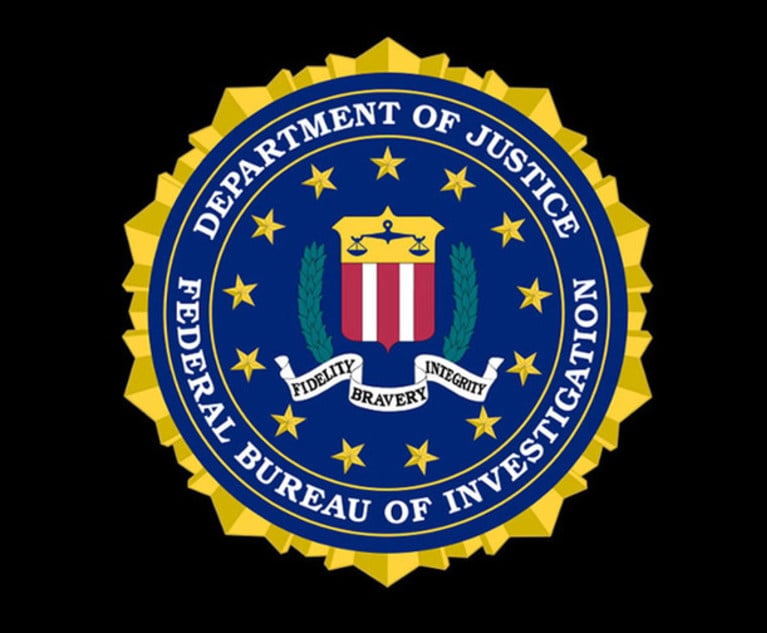Health Care Fraud and Abuse Practice: Change Is in the Air
Substantial changes to health-care fraud and abuse laws appear to be on the horizon. If these changes come to fruition, a sizable swath of health law regulatory practice may be replaced, if not largely disappear.
February 08, 2019 at 12:00 PM
8 minute read

Substantial, if not fundamental, changes to health-care fraud and abuse laws appear on the horizon in light of the U.S. Department of Human Services “Regulatory Sprint to Coordinated Care.” If proposed changes submitted by key stakeholders come to fruition, a sizable swath of health law regulatory practice may be replaced, if not largely disappear. That is, the need to fit a wide range of innovative provider arrangements into complex and confusing Stark exceptions and Anti‑Kickback Safe Harbors may become largely obsolete,
Earlier this year, two federal agencies, the Centers for Medicare and Medicaid Services (CMS) and the Office of Inspector General (OIG) within the Department of Health and Human Services (HHS), issued formal requests for information to seek input to further the “Regulatory Spring to Coordinated Care” launched by HHS. Published responses from a wide range of affected constituents (e.g., numerous hospital associations, physician societies and associations, and trade groups) reveal numerous common threads that portend potentially fundamental change to fraud and abuse laws.
|The Problem
• Silos Confound Value-Based Payment Models and Clinical Integration
Primary goals of the Stark Law (42 U.S.C. 1395nn) and the Anti-Kickback Statute (42 U.S.C. §1320a‑7b(b)) include eliminating over-utilization of health-care services payable by the federal government. This is accomplished by either criminalizing, imposing civil monetary penalties, or imposing other legal sanctions (such as exclusion from Medicare) against health-care providers and other individuals who violate those laws. The resulting sets of statutes, regulations, formal waivers, other formal governmental guidance, and case law can be exceedingly complex, requiring careful navigation by specialized legal counsel. Unintended missteps can lead to harsh results.
In large measure, existing federal health-care fraud and abuse laws create an “isolation bias” that requires mapping and separating financial interests of health-care providers in order to ensure that patient referrals cannot be tainted by self-interest. Under Stark, a strict liability law, physicians cannot make a referral for the provision of “designated health services” to an entity in which they have a financial relationship (unless one of approximately 30 exceptions applies). The general construct is that the referring physician must be separated from the provider to which he or she refers. Under the Anti-Kickback Statute, common financial relationships involving providers of, for example, office space leases, equipment leases and professional services can be deemed legally suspect unless they fit within a “safe harbor,” which are typically structured to ensure arms-length negotiation that cannot be based on the volume or value of referrals.
The problem is, today, isolation of providers is the enemy. When Congress replaced Medicare's dreaded “sustainable growth rate” with the Medicare Access and CHIP Reauthorization Act of 2015 (MACRA), it laid the foundation for Alternative Payment Models (APMs) that require provider integration and coordination. Today, we speak of clinically integrated networks (CINs), alternative payment models (APMs), accountable care organizations (ACOs), and bundled payment models (BPMs), all of which are based on clinical and financial integration and coordination—not isolation.
• Complexity
The complex requirements of various Stark exceptions and Anti-Kickback Safe Harbors often confound the development of innovative care management models. Correctly structuring innovative financial incentives and disincentives—the ultimate drivers of behavior—requires careful and sophisticated analysis of this “mind-numbing” array of rules (See Aug. 24, 2018, submission to CMS from Medical Group Management Association).
• Cost of Compliance
Hiring the requisite expertise, i.e., specialized counsel and valuation experts to sort through legal issues and perform quantitative analyses, was cited by many commentators as both necessary and expensive—even for simple leasing, employment and administrative services agreements.
• Chilling Effect
Often, providers abandon ideas for innovative health management models due to concerns about having to defend them. Comments submitted to CMS and the OIG reveal a certain irony: innovative models designed to maintain quality and control utilization are abandoned because they can't comply with cumbersome and arcane governmental requirements designed to do the same thing—maintain quality and control utilization—but designed in a different era.
|Requests for Information from CMS and OIG
On June 25, 2018, CMS published a “Request for Information Regarding the Physician Self-Referral Law” (83 FR 29524). Two months later, on Aug. 27, 2018, the OIG published a “Request for Information Regarding the Anti-Kickback Statute and Beneficiary Inducements CMP” (83 FR 43607). A review of published comments submitted in response to these two RFIs reveals similar recommendations and analyses from a veritable chorus of hospital associations, physician associations, and other trade groups:
• Create a Broad Exception/Safe Harbor for Alternative Payment Models
Commenters overwhelmingly implored CMS and OIG to permit—on a comprehensive basis—participation in value-based care and alternative payment models that incorporated verifiable components pertaining to care management, quality and cost control. In addition, the form of permission should apply across the board to all types of plans and all types of patients; that is, rather than be restricted to Medicare APMs, MCOs, MSSPs and Bundled Payments Models, the blanket permission should encompass commercial plans and Medicaid and essentially be “plan agnostic.”
• Create an Exception/Safe Harbor for Cybersecurity
Commenters overwhelmingly urged CMS and OIG to permit providers (e.g., physicians and physician groups) to receive donations of cybersecurity technology (e.g., training, hardware, software) from other providers (e.g., hospitals and hospital systems). It was also urged that the recipients of the cyber technology should not be required to meet a minimum contribution criterion, such as the 15 percent of the donor's cost requirement under the existing Stark exception for electronic health records. 42 CFR 357.411(w)(4).
• Expand Safe Harbors to Promote Patient Access and Recognize Social Determinants of Health
Another common refrain from numerous commenters was to eliminate barriers to patient access by loosening existing safe-harbor criteria for local transportation and waivers of copayments, coinsurance and deductibles. Additionally, as health-care systems have assumed more responsibility for patient outcomes, their perspectives have broadened from individual health to population health. Improving access to stable housing, healthy foods and physical safety has been recognized as a valid goal of health-care delivery systems. The agencies were thus asked by several commenters to expressly permit expenditures for “health-related nonmedical services” that, under existing law, could be characterized as inappropriate inducements. (See Oct. 26, 2018, submission to the OIG from Bruce Siegel, MD, President and CEO America's Essential Hospitals and former New Jersey Commissioner of Health.)
• Merge AKS and Stark Exceptions/Safe Harbors
Complying with two similar, but not identical, sets of legal requirements was cited as a problem by a numerous commenters, who overwhelmingly suggested that compliance requirements for the AKS and Stark should be identical. Some commenters took this a step further and urged CMS and the OIG to initiate discussions with state governments to align similar state laws regarding self-referral prohibitions and anti-kickback laws with federal law.
• Formalize, Extend and Expand Existing Waivers
The current federal fraud and abuse waivers, issued on a program-by-program basis for ACOs and bundled payments programs, have been issued by CMS and the OIG pursuant to their statutory authority under Section 1115A(d)(l) and Section 1899(f) of the Social Security Act. Many commenters urged CMS and the OIG to subject those waivers to formal rule-making procedures and codify them permanently. Commenters also urged CMS and OIG to replace the existing program-specific waivers with a broad, overarching waiver applicable to all innovative patient care models that incorporate quality, efficiency, coordination and cost control.
|Conclusion
Federal fraud and abuse laws, the bane of physicians' and hospital executives' existence, are poised for retooling. The federal government's objective to cut regulations, and the health-care industry's nearly uniform desire to achieve that objective, forms a formidable merger of private and public institutions with the same goal. If fraud and abuse laws are relaxed to accommodate all forms of value-based payment models, transactions governing provider relationships should be easier and less expensive to accomplish because the need for legal and valuation expertise should be diminished. The volume of provider and payor transactions should also increase (and become more interesting) as more innovative value-based purchasing models are launched across the health-care sector.
Policy-wise, it remains unknown whether the retooled laws would achieve the goal of lowering the total cost of care, i.e., bend the cost curve downward. Or, would these changes prove to be nothing more than the opening of a floodgate that simply enlarges the health-care sector, increases overall spending, and ultimately bends the curve the wrong way. Whichever way the cost curve ultimately bends, relaxation of existing fraud and abuse laws to accommodate value-based purchasing and population health goals should lead to more innovation, more provider collaboration, and more attention paid to quality assessment.
Barry Liss is a Director and Healthcare Team Leader at Gibbons P.C. in Newark. His practice has been exclusively devoted to healthcare law for more than 20 years and focuses on corporate and regulatory healthcare-related law.
This content has been archived. It is available through our partners, LexisNexis® and Bloomberg Law.
To view this content, please continue to their sites.
Not a Lexis Subscriber?
Subscribe Now
Not a Bloomberg Law Subscriber?
Subscribe Now
NOT FOR REPRINT
© 2024 ALM Global, LLC, All Rights Reserved. Request academic re-use from www.copyright.com. All other uses, submit a request to [email protected]. For more information visit Asset & Logo Licensing.
You Might Like
View All
3rd Circuit Strikes Down NLRB’s Monetary Remedies for Fired Starbucks Workers


As Trafficking, Hate Crimes Rise in NJ, State's Federal Delegation Must Weigh in On New UN Proposal
4 minute read
Trending Stories
- 1'Largest Retail Data Breach in History'? Hot Topic and Affiliated Brands Sued for Alleged Failure to Prevent Data Breach Linked to Snowflake Software
- 2Former President of New York State Bar, and the New York Bar Foundation, Dies As He Entered 70th Year as Attorney
- 3Legal Advocates in Uproar Upon Release of Footage Showing CO's Beat Black Inmate Before His Death
- 4Longtime Baker & Hostetler Partner, Former White House Counsel David Rivkin Dies at 68
- 5Court System Seeks Public Comment on E-Filing for Annual Report
Who Got The Work
Michael G. Bongiorno, Andrew Scott Dulberg and Elizabeth E. Driscoll from Wilmer Cutler Pickering Hale and Dorr have stepped in to represent Symbotic Inc., an A.I.-enabled technology platform that focuses on increasing supply chain efficiency, and other defendants in a pending shareholder derivative lawsuit. The case, filed Oct. 2 in Massachusetts District Court by the Brown Law Firm on behalf of Stephen Austen, accuses certain officers and directors of misleading investors in regard to Symbotic's potential for margin growth by failing to disclose that the company was not equipped to timely deploy its systems or manage expenses through project delays. The case, assigned to U.S. District Judge Nathaniel M. Gorton, is 1:24-cv-12522, Austen v. Cohen et al.
Who Got The Work
Edmund Polubinski and Marie Killmond of Davis Polk & Wardwell have entered appearances for data platform software development company MongoDB and other defendants in a pending shareholder derivative lawsuit. The action, filed Oct. 7 in New York Southern District Court by the Brown Law Firm, accuses the company's directors and/or officers of falsely expressing confidence in the company’s restructuring of its sales incentive plan and downplaying the severity of decreases in its upfront commitments. The case is 1:24-cv-07594, Roy v. Ittycheria et al.
Who Got The Work
Amy O. Bruchs and Kurt F. Ellison of Michael Best & Friedrich have entered appearances for Epic Systems Corp. in a pending employment discrimination lawsuit. The suit was filed Sept. 7 in Wisconsin Western District Court by Levine Eisberner LLC and Siri & Glimstad on behalf of a project manager who claims that he was wrongfully terminated after applying for a religious exemption to the defendant's COVID-19 vaccine mandate. The case, assigned to U.S. Magistrate Judge Anita Marie Boor, is 3:24-cv-00630, Secker, Nathan v. Epic Systems Corporation.
Who Got The Work
David X. Sullivan, Thomas J. Finn and Gregory A. Hall from McCarter & English have entered appearances for Sunrun Installation Services in a pending civil rights lawsuit. The complaint was filed Sept. 4 in Connecticut District Court by attorney Robert M. Berke on behalf of former employee George Edward Steins, who was arrested and charged with employing an unregistered home improvement salesperson. The complaint alleges that had Sunrun informed the Connecticut Department of Consumer Protection that the plaintiff's employment had ended in 2017 and that he no longer held Sunrun's home improvement contractor license, he would not have been hit with charges, which were dismissed in May 2024. The case, assigned to U.S. District Judge Jeffrey A. Meyer, is 3:24-cv-01423, Steins v. Sunrun, Inc. et al.
Who Got The Work
Greenberg Traurig shareholder Joshua L. Raskin has entered an appearance for boohoo.com UK Ltd. in a pending patent infringement lawsuit. The suit, filed Sept. 3 in Texas Eastern District Court by Rozier Hardt McDonough on behalf of Alto Dynamics, asserts five patents related to an online shopping platform. The case, assigned to U.S. District Judge Rodney Gilstrap, is 2:24-cv-00719, Alto Dynamics, LLC v. boohoo.com UK Limited.
Featured Firms
Law Offices of Gary Martin Hays & Associates, P.C.
(470) 294-1674
Law Offices of Mark E. Salomone
(857) 444-6468
Smith & Hassler
(713) 739-1250






